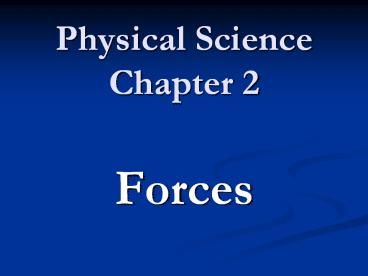Physical Science Chapter 2 - PowerPoint PPT Presentation
Title:
Physical Science Chapter 2
Description:
Physical Science Chapter 2 Forces * The Nature of Force By definition, a Force is a push or a pull. A Push Or A Pull Just like Velocity & Acceleration Forces have ... – PowerPoint PPT presentation
Number of Views:895
Avg rating:3.0/5.0
Title: Physical Science Chapter 2
1
Physical ScienceChapter 2
- Forces
2
The Nature of Force
- By definition, a Force is a push or a pull.
A Push Or A Pull
Just like Velocity Acceleration Forces have
both magnitude and direction components
3
Balanced Unbalanced Forces
- With a Balanced force opposite and equal forces
acting on the same object result in NO motion of
the object - Unbalanced forces two or more forces of unequal
strength or direction acting upon on an object
results in the motion of the object
4
Vectors
- Vectors are a method used to visually show forces
- A vector is a quantity which has both magnitude
(size) and direction. - The length of the arrow shows the magnitude of
the vector. - The angle of the arrow shows the vector's
direction. - Just like numbers, we can add two or more
vectors together and get a net force called the
resultant
5
Adding 2 or More Vectors
Fig 1
Fig 3
Fig 2
- Add vectors A and B to get the Resultant C
- A B C
- Fig 1 - shows the magnitude direction of the 2
vectors we are adding - Fig 2 we move the beginning of vector B to the
end of Vector A, making sure to keep the
magnitude direction exactly the same - Fig 3 Connect the beginning of Vector A to the
end of Vector B, this is your Resultant C.
Click the icon to run java script game that
allows you to add vectors
6
Newtons 3 Laws of Motion
- Newtons 1st Law of Motion
- AKA The Law of Inertia
- which states an object at rest will remain at
rest, and an object in motion will remain in
motion at a constant velocity until acted on by
another force.
Remember The greater the mass of an object the
greater the inertia
7
Newtons 3 Laws of Motion
- Newtons Second Law of Motion aka Fma
- Force mass x acceleration
- Can be written as
- Fma a F/m m F/a
- What is the basic unit for mass? Kilogram
- What is the basic unit for acceleration?
Meter/sec/sec - Therefore the basic unit for Force is
- (kilogram)( meter/sec/sec)
- An object with a mass of 1 kg accelerating at 1
m/s/s has a force of 1 Newton
Ding-a-ling!!
8
Newtons 2nd Law Force of Gravity
- Everyone has heard of the FORCE of gravity
- So far, we know only of four types of fundamental
forces in nature - Gravity, Electromagnetic, Weak, and Strong
- Gravity the force that pulls objects towards
each other - Since gravity is a force it also obeys Newtons
second law - Fma
Since objects fall at the same speed, their
acceleration is the same. All objects accelerate
at the rate. Here on Earth the rate is Ag9.8
m/s2 Or Ag32 ft/s2
With this experiment, Galileo proved Aristotle
wrong
Air resistance keeps things from falling equally
With this experiment, Apollo 15 astronauts proved
Galileo right. (link to You Tube)
9
Newtons 2nd Law Weight
- Fma
- Weight is the force of gravity acting on an
objects mass. - Therefore weight is a type of Force
- The formula for weight Weight mass x Ag
- Since Ag 9.8 m/s2 then
- Weight mass x 9.8 m/s2
- Got it? I hope so its a ding-a-ling!
Remember 1 newton 0.22 pounds
10
Your weight on other planets 3 different types
of stars
11
Newtons 3 Laws of Motion
- Newtons 3rd Law of Motion
- For every action there is an equal opposite
reaction. - If an object is not in motion, then all forces
acting on it are balanced and the net force is
zero! - Friction the force that one surface exerts on
another when the two rub against each other.
Fluid friction
Sliding friction
Rolling friction
12
Momentum
- An objects momentum is directly related to both
its mass and velocity. - Momentum mass x velocity
- For some reason, maybe because mass is designated
as m in formulas, momentum is designated as
p. - Therefore p mv
- The unit for mass is kg, the unit for velocity is
meter/second, therefore the unit for momentum is
kg m/sec - Conservation of Momentum
- When two or more objects interact (collide) the
total momentum before the collision is equal to
the total momentum after the collision
13
Momentum 2 moving objects
- During this collision the speed of both box cars
changes. The total momentum remains constant
before after the collision. The masses of both
cars is the same so the velocity of the red car
is transferred to the blue car.
14
Momentum 1 moving object
- During this collision the speed red car is
transferred to the blue car. The total momentum
remains constant before after the collision.
The masses of both cars is the same so the
velocity of the red car is transferred to the
blue car.
15
Momentum 2 connected objects
- After this collision, the coupled cars make one
object w/ a total mass of 60,000 kg. Since the
momentum after the collision must equal the
momentum before, the velocity must change. In
this case the velocity is reduced from 10 m/sec.
to 5 m/sec.
16
Lets call it a night. Take a break.Cya Later!































